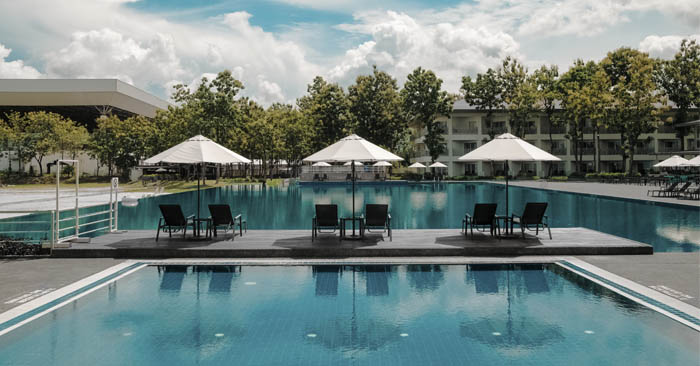 Bernadette Spofforth
Bernadette Spofforth
CEO, Splash About
Mom of 3
All the advice says swimming is a life skill, start it earlier rather than later.
 We all recognize the widely publicized health benefits of swimming from a young age; from helping to develop good exercise habits for life to teaching children about water safety and in doing so, helping to reduce tragic accidents every year from drowning.
We all recognize the widely publicized health benefits of swimming from a young age; from helping to develop good exercise habits for life to teaching children about water safety and in doing so, helping to reduce tragic accidents every year from drowning.
Learning to swim is a fantastic way for families to have fun and keep fit at the same time – and it makes for great bonding. A recent survey conducted by Splash About revealed that moms and dads were more likely to feel an increased connection with their baby after they had been swimming together. Plus, fathers in particular felt more confident with their parenting skills after swimming with their baby.
And it’s not just good for parents – nearly a quarter of respondents found that their child slept better after swimming and seemed in a happier mood – indeed, there is evidence to show that water massaging the body releases endorphins or happy hormones that gives a sense of wellbeing, promoting definite psychological benefits.
Swimming is particularly good for young children too because it helps build cardiovascular fitness, promotes balance, strength and coordination, improves stamina, helps develop joint mobility and flexibility and strengthens muscles. At the same time it emphasizes overall fitness as nearly all muscles are used during a swimming session.
The key elements when teaching children to swim are to make it fun and make them feel confident and comfortable in the water. The first year of a baby’s life is crucial in terms of their physical development and gaining new experiences, so it’s a perfect time to introduce them to swimming classes. Starting early also means they’re less likely to develop a fear of water that can occur in older children.
What about a swim diaper?
Although pools are treated to deal with urine, poop in the pool is not only a health risk, but also a costly accident, as the entire pool has to be drained and cleaned.
An effective leak-prevention swim diaper is an essential part of your baby’s swim kit. Cloth diapers with a plastic coated shell are not effective but a neoprene swim diaper will help prevent fecal leaks keeping pool water safe and clean for all swimmers.
Help my baby doesn’t enjoy swimming classes!
What happens if your baby develops water wobbles after enjoying lessons for months? Reluctant swimmers can present themselves when you least expect it. Here are a couple of tried and tested tips to entice them back into the water…
First swimming experiences can be a shock and many babies and toddlers will cry and fuss for the first few lessons, this is a case of persevering and talking to your swim teacher.
However from our knowledge of the swimming industry and working with swim teachers, it is most likely that nine out of 10 babies cry because they are cold, even in warm water. This is because young babies aren’t as active and won’t be moving about much in the water, and as a result, they’ll feel the cold quicker than you will.
A warm baby is a happy baby so it’s time to invest in a baby wetsuit. Wetsuits for babies should be made from malleable soft neoprene, which is designed to maintain a baby’s core temperature keeping them happier in the water for longer so you don’t have to leave swim classes early with a shivering baby.
You may also want to invest in a foam changing mat; these are great as they are heat-reflecting and don’t absorb water so they help to ease the transition from chilly changing room to pool water.
Don’t feel that you have to stay in the pool for ages – getting your child used to the water can be a gradual process. You can increase the time you spend in the pool as they get older and more active, but for the first few times that you take them it’s more about getting acclimatized to the water and their surroundings.
Is it worth investing in swim toys?
Sometimes distraction techniques can be helpful for reluctant swimmers. The baby swim mirror is a concept that has rapidly gained momentum since its introduction into a number of international swim schools. A wet smiling reflection provides a welcome distraction for babies who are not yet relaxed in the water and it’s a fun way to stop worried tears.
Babies learn through play so investing in a few great CE marked toys is also a must, but be careful about non CE marked toys because the paint tends to flake off after exposure to chlorine and this can be dangerous when mouthed by teething babies.
Taking your baby or toddler swimming for the first time can be a bit daunting; just the practicalities of getting you both changed can put a lot of people off. However, if you make it a part of your baby’s routine from an early age, it can become an activity that you both enjoy.
When should I start to use water-wings?
Once your toddler is comfortable in the water a floatation aid is a great next step. Water-wings have, for a long time, been an obvious choice, however they do restrict arms and don’t allow children the freedom of movement. Foam floats or water noodles are helpful but you are reliant on young children holding on which isn’t always practical or safe.
Many parents have started to invest in float suits or jackets with adjustable buoyancy. These products have integrated foam floats inserted into the suit and centered around the child’s middle and back which can be removed to tailor individual buoyancy.
A float suit has the advantage of correctly positioning the child in the water for learning to swim and will also allow complete freedom of movement for both legs and arms. Importantly too, it will let the child develop a good sense of their own buoyancy.
Although parents should always be vigilant when children are playing around water, a reputable float suit is ideal for a vacation or if you have a pool at home as it can offer parental peace of mind; should your child accidently fall in the water they are safer wearing a float suit.
When shopping for float suits, choose one that is made from fabric that is UPF50+ certified so it offers the maximum sun protection both in and out of the water. Also look for suits with numerous small shaped floats as opposed to fewer and flatter floats – this style will be more comfortable to wear and easier to adjust buoyancy.
Be warned though, these suits can be a struggle to put on and take off so make sure you choose one with a full back zip at the back to avoid changing room tussles!
Whenever you choose to introduce your baby to the joys of swimming, remember be patient – sometimes having fun takes practice!
Bernadette Spofforth

Bernadette Spofforth (mum of 3) is CEO of British brand Splash About which designs & develops some of the most advanced safety swimwear for babies and children available on the market today
Save
Save
Save






8 Comments on “The Benefits of Baby Swimming”
I love how you said that swimming lessons are good for kids because it works on cardiovascular fitness and helps them master balance, strength, coordination, and staying power. Our child doesn’t do much in the way of physical exercise. He loves spending his time watching others play or watching television. This concerns me in regards to his physical health. Fortunately, he loves the water, so swimming lessons to promote fitness and growth make sense. We will set him up with lessons from a professional before summer.
Great article. I am waiting for my baby to become 4 months old then I start teaching her swimming.
Well for me Swimming is one of the best exercise. And I have enrolled my children into swimming academy when they were 2 months old.
That’s great! Swimming is also a great bonding time between parent and baby :)
Thanks for sharing this article the information will be so helpful as my daughter is thinking of enrolling her 3 month old son into swimming lessons,and you are so correct the earlier you start them the better.
My son learned to swim at a very young age and I’ve always been grateful for that–he has had no fear or anxiety about water or swimming, etc. because of it and that was an issue that I grew up having! It also is so good to know in the case of an emergency and them needing to know how to swim to save themselves!
I like what this article mentions about the cardio benefits of swimming. It makes sense that babies don’t get very much exercise but swimming could be a good way to change this. I’ll have to keep this in mind to make sure I can get my kid enough exercise with swimming lessons.
I have wondering when to take my second daughter to swim lesson since every year I take my oldest daughter to summer swim lesson. I may have to wait one more year until my second daughter is not very shy and afraid of anything. She is also wearing diapers right now at almost 2 1/2 years old. I do love the fact of kids learning how to swim in case of drowning in the pool.